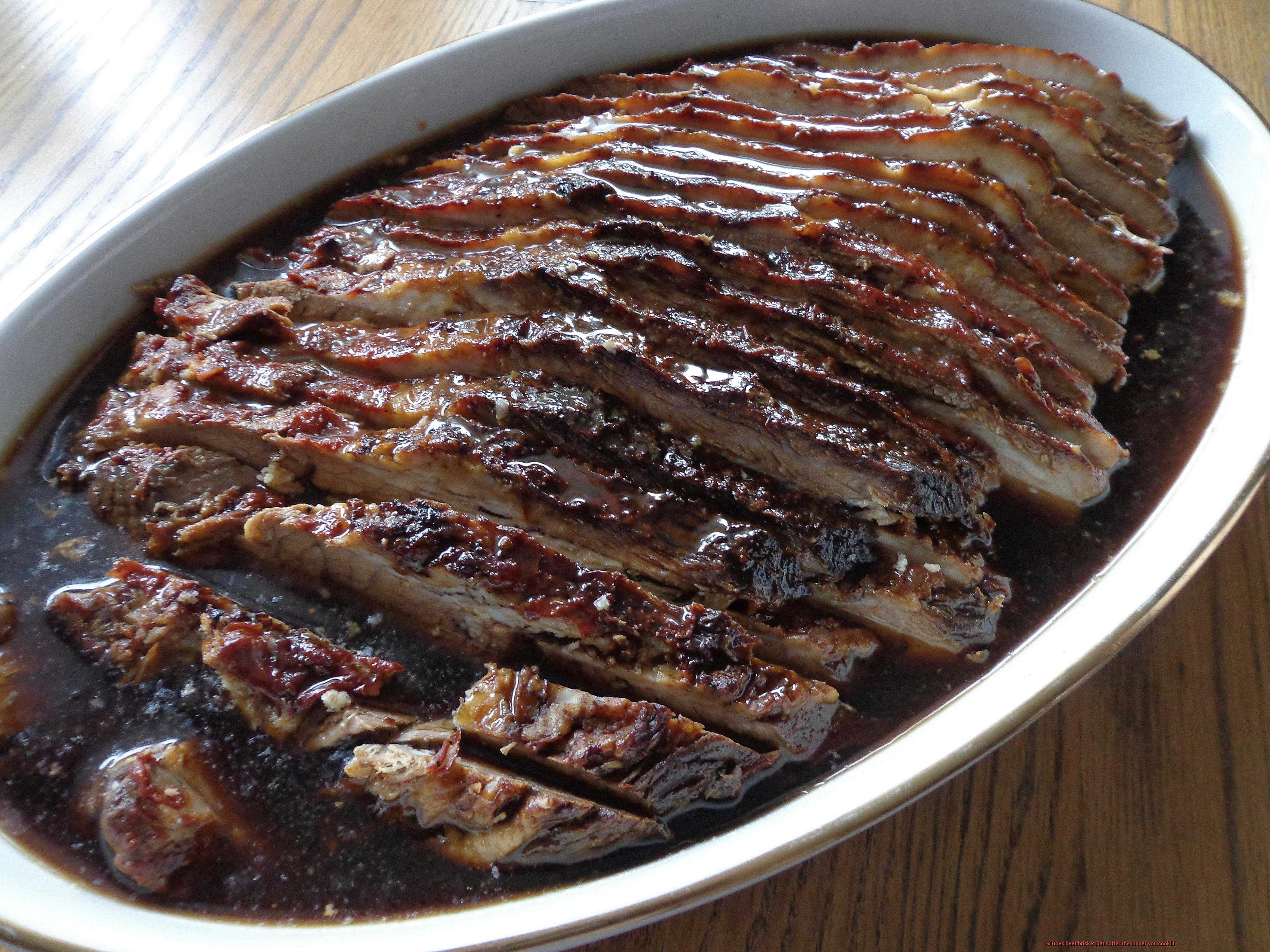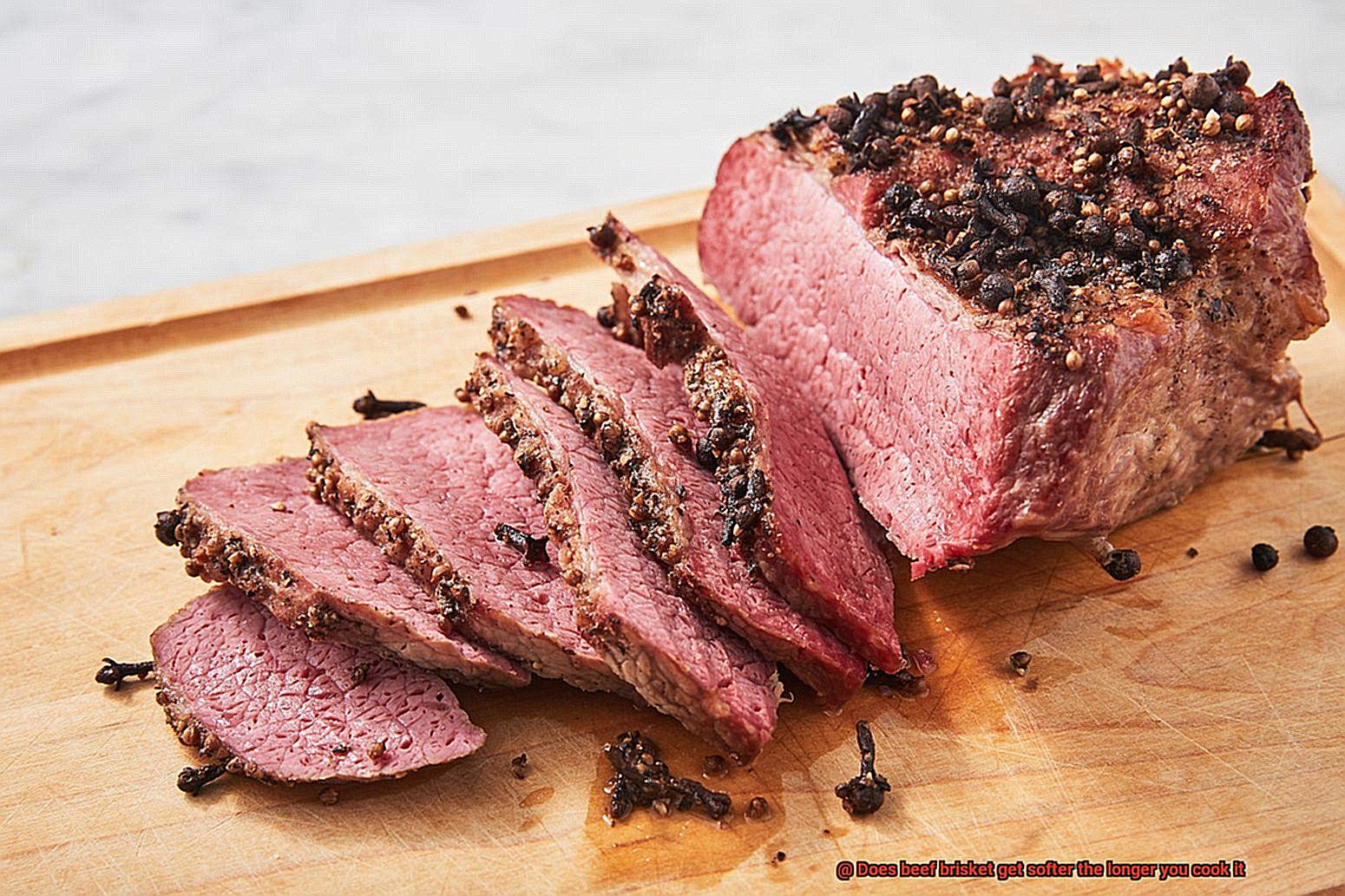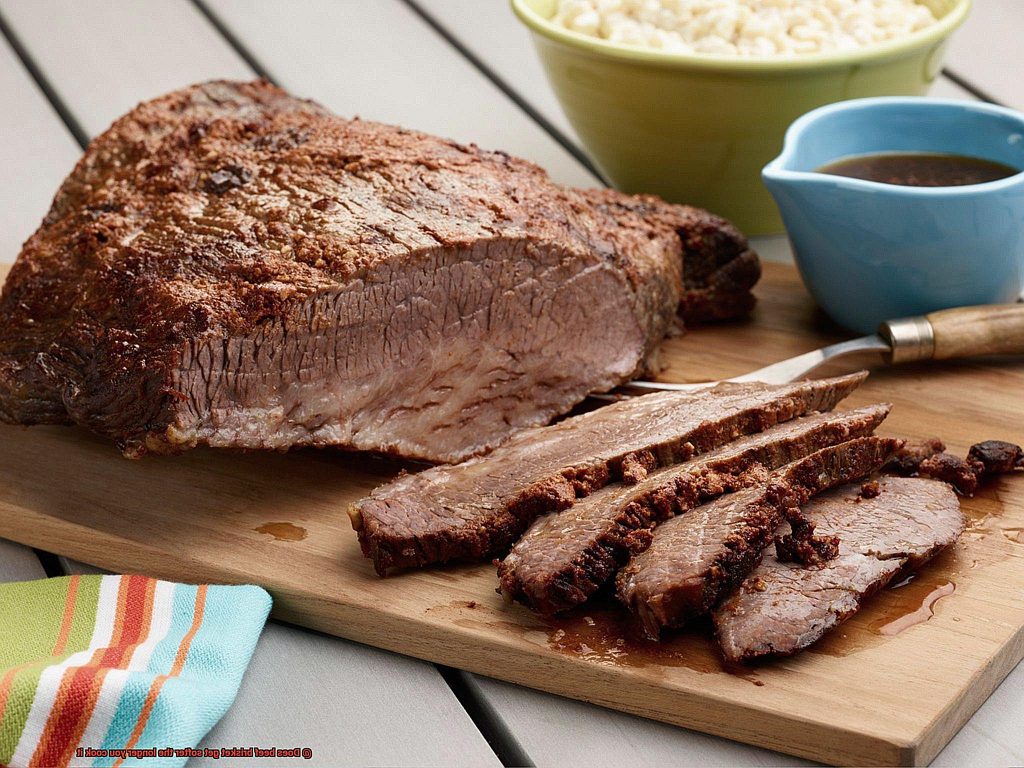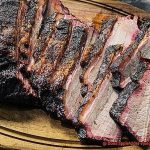Are you a self-proclaimed brisket enthusiast? Do you find yourself salivating at the thought of biting into a succulent, melt-in-your-mouth brisket? If so, then you’ve probably wondered if beef brisket gets softer the longer it cooks. Well, wonder no more – we’re here to spill the beans.
The short answer is yes – cooking beef brisket for an extended period of time can result in a tender and juicy masterpiece. But, as with any culinary endeavor, there’s a science behind achieving that perfect texture. From selecting the right cut of meat to choosing the ideal cooking method, there are several factors to consider when making your own mouthwatering brisket.
In this blog post, we’ll dive deep into all things brisket-related. Whether you’re a seasoned pitmaster or a novice cook, we’ve got you covered with tips and tricks to help you master this beloved dish. So grab your apron and let’s get started on our quest for the ultimate tender beef brisket.
Contents
The Science Behind How Beef Brisket Gets Softer
The secret lies in the science behind how beef brisket gets softer, a fascinating topic that has been studied by food scientists and chefs alike.
The key to tender brisket is understanding the connective tissue and collagen that make up the muscle fibers. When cooked for an extended period, the collagen breaks down and becomes more tender, resulting in a softer texture. This process is known as collagen hydrolysis and can take hours to achieve, depending on the size and thickness of the brisket.
But cooking time alone won’t get you that perfect brisket. The temperature at which the meat is cooked is also crucial in determining its tenderness. Low and slow cooking temperatures, typically between 225-250°F, are ideal for gradually breaking down the collagen without drying out the meat.
And let’s not forget about resting time. After cooking, it’s essential to allow the meat to rest for at least 30 minutes. During this time, the juices redistribute throughout the meat, resulting in a more evenly flavored and tender final product.
Achieving the perfect balance of tenderness without sacrificing flavor or moisture requires patience and attention to detail. Monitoring the internal temperature throughout the cooking process ensures that your brisket is cooked just right.
Why Low and Slow Cooking is Best for Beef Brisket
If you’re a carnivore who craves a tender and juicy beef brisket, then low and slow cooking is the tried-and-true method that you need to master. As an expert on this topic, I can tell you with utmost confidence that this method will produce the best results for your taste buds. Here’s why:
Firstly, the nature of brisket is such that it comes loaded with connective tissues and collagen that can make it tough and chewy if not cooked properly. Cooking the brisket at a low temperature for an extended period of time is the key to breaking down these stubborn elements gradually. This process results in a melt-in-your-mouth texture that is sure to please.
Secondly, cooking brisket at high temperatures or for short periods of time can dry out the meat, leaving it tough and unappetizing. With low and slow cooking, however, the moisture in the meat is retained, resulting in a moist and tender final product.
But wait, there’s more. Low and slow cooking also allows for the flavors of your seasoning and rub to penetrate deeply into the meat. The prolonged cooking time allows these flavors to marry together and develop into a rich, complex taste that will leave you wanting more.
So, if you’re looking to up your brisket game, low and slow cooking is the way to go. Whether you choose to smoke, roast or braise your brisket, make sure you give yourself ample time to get it just right. Patience is key when it comes to mastering this culinary art form.
To summarize, here are some of the reasons why low and slow cooking is best for beef brisket:
- Slow cooking breaks down connective tissues and collagen for a tender texture
- Low temperatures retain moisture for juicy meat
- Prolonged cooking time allows flavors to meld together for rich, complex taste
Measuring Internal Temperature for Perfect Results
Achieving that level of perfection requires measuring the internal temperature of the meat.
To accurately measure internal temperature, a meat thermometer is essential. Two types of meat thermometers are available: instant-read and leave-in. The instant-read thermometer is perfect for quickly checking the temperature, while the leave-in thermometer is inserted into the meat and remains in place throughout the cooking process.
When using a meat thermometer, ensure that it is inserted into the thickest part of the brisket without touching any bone or fat. This will provide an accurate reading of the internal temperature. The desired internal temperature for beef brisket varies depending on how well-done you prefer it.
For a rare brisket, aim for an internal temperature around 130°F (54°C). A medium-rare brisket should be cooked to an internal temperature of 135-140°F (57-60°C). Medium and medium-well briskets should have internal temperatures of 145-155°F (63-68°C) and 160°F (71°C) respectively. If you prefer your brisket well-done, aim for an internal temperature between 170-180°F (77-82°C).
It’s crucial to note that as beef brisket cooks, it becomes more tender but also drier. For maximum tenderness and juiciness, cook your brisket until it reaches an internal temperature between 195-205°F (91-96°C). Once your brisket reaches this temperature, remove it from the heat and let it rest for at least 30 minutes before slicing and serving.
The Importance of Letting the Meat Rest After Cooking
As a culinary expert, I’m here to give you an in-depth understanding of why letting your meat rest is crucial for achieving the perfect texture and taste.
Resting your meat after cooking allows the juices to redistribute evenly throughout the meat, ensuring that every bite is moist and flavorful. Without resting, the meat can become dry and tough as the juices flow out and evaporate quickly upon cutting. It’s not something you want to experience, is it?
But how long should you let your meat rest? It’s recommended that you allow it to rest for at least 20-30 minutes before slicing into it. This will give ample time for the juices to settle back into the meat fibers. To do this correctly, remove it from the heat source and tent it with foil, which will keep it warm while also allowing excess steam to escape, preventing the meat from becoming soggy.
Resting your meat not only enhances its texture and flavor but also makes it easier to slice evenly. Slicing too soon can result in uneven pieces and jagged edges, making it difficult to serve or eat. By allowing the brisket to rest, you can ensure that each slice is visually appealing and consistent.
Tips for Achieving Perfectly Cooked and Tender Beef Brisket
Here are some tips to take note of:
Choose the Right Cut of Meat:
The success of your brisket starts with the cut of meat you choose. The point cut is the best option for tender and juicy brisket. This cut has more marbling and fat, which helps keep the meat moist during cooking. If you prefer a leaner cut, go for the flat cut, but be aware that it may not be as tender.
Season and Marinate:
A good seasoning or marinade can make all the difference in flavor and tenderness. A simple mixture of salt, pepper, garlic, and onion powder can enhance the natural flavor of the beef, while a marinade can add extra moisture and flavor. Consider adding beer or apple cider vinegar to your marinade for an extra level of deliciousness.
Low and Slow Cooking:
For perfectly cooked and tender beef brisket, slow cooking is the way to go. Cook the brisket at a low temperature (225-250°F) for several hours. This allows enough time for the connective tissue to break down and become tender. Some recipes even suggest cooking for up to 12 hours.
Wrap It Up:
Wrapping the brisket in foil or butcher paper during cooking helps trap in moisture and creates a “braising” effect that further tenderizes the meat. This technique can also help reduce cooking time while still achieving a tender result.
Rest is Key:
Letting the brisket rest for at least 30 minutes before slicing is crucial in achieving a tender and flavorful final product. During this time, the juices redistribute throughout the meat, resulting in a more succulent and tender bite.
Different Techniques for Cooking Beef Brisket
As an expert in this area, I am here to guide you through the unique benefits and challenges of each method.
First up is smoking. This technique involves low and slow cooking over wood chips or chunks, resulting in a tender and smoky final product. The benefit of smoking is the intense flavor profile it adds to the meat, making it perfect for those who crave a deep and rich taste. However, it can take up to 14 hours to cook, so if you’re short on time, this may not be the best option. But believe me; it’s worth the wait when you get to savor the aroma of perfectly smoked brisket.
Braising is another technique that doesn’t require much attention once the meat is in the pot. Here, the brisket is cooked in a liquid such as broth or wine over low heat for a few hours. The result is a tender and juicy meat with a flavorful sauce. Braising is perfect for busy cooks as it requires minimal attention once you put the meat on. However, if you’re looking for an intense smoky flavor, braising may not be your go-to method.
Last but not least is grilling. It’s essential to make sure you have careful temperature control when grilling beef brisket as it can result in a less tender product if not done correctly. Grilling involves cooking the brisket over direct heat, resulting in a crisp outer layer. The shorter cooking time makes it ideal for those who are short on time – if done right, you can have your brisket ready in under an hour.
Regardless of which technique you choose, always remember to let your brisket rest for at least 30 minutes before slicing. This allows the juices to redistribute throughout the meat, ensuring maximum tenderness and flavor.
To sum up, here are the three different techniques for cooking beef brisket:
- Smoking: low and slow cooking over wood chips or chunks that produce a tender and smoky result but takes up to 14 hours.
- Braising: cooking the brisket in a liquid such as broth or wine over low heat for a few hours that produces a tender and juicy meat with a flavorful sauce.
- Grilling: direct heat cooking that results in a crisp outer layer and takes less time than smoking or braising.

Common Mistakes to Avoid When Cooking Beef Brisket
With a few simple steps, you can avoid these pitfalls and create a mouth-watering masterpiece that will have everyone coming back for more.
First and foremost, don’t rush the cooking process. Beef brisket is a tough cut of meat that needs to be cooked low and slow for several hours to break down the connective tissue and become tender. Resist the urge to crank up the heat or cut corners on cooking time – patience is key.
Next up, seasoning is crucial. A good brisket rub should include salt, pepper, garlic, onion powder, paprika, and other spices to enhance the flavor of the meat. Don’t be afraid to get creative with your seasoning blend, but make sure to let it rest for at least 30 minutes before cooking to allow the flavors to penetrate the meat.

Choosing the right cooking method is also important. While grilling or smoking are popular options, they require careful attention and monitoring to avoid overcooking or drying out your meat. Maintain a consistent temperature throughout the cooking process and resist the temptation to open the grill or smoker too often, which can cause fluctuations in temperature and longer cooking times.
Last but certainly not least – slicing your brisket. This seemingly small detail can make all the difference in ensuring tender, juicy meat. Always slice against the grain of the meat to keep it tender and avoid chewy pieces.
What to Serve with Beef Brisket?
The right pairings of sides and sauces. Here are five delicious and creative options to serve with your beef brisket that will make your taste buds sing.
Classic BBQ Sides
Nothing says BBQ like classic sides such as coleslaw, potato salad, and baked beans. These staples provide the perfect balance of cool, creamy, and tangy flavors that can cut through the richness of the meat. They also add texture and color to your plate, making it a feast for both the eyes and the taste buds.
Grilled Vegetables
For a healthier option, try grilling vegetables like zucchini, eggplant, bell peppers, and onions. The smoky sweetness of grilled vegetables complements the meat perfectly while providing a fresh contrast in texture and taste. Plus, grilling vegetables brings out their natural flavors and makes them even more delicious.
Mac and Cheese
Who doesn’t love mac and cheese? The creamy, cheesy goodness of this classic comfort food is a great complement to the tender meat. Plus, it’s easy to customize by adding bacon bits or jalapeños for a spicy kick.
Cornbread
Cornbread is a Southern staple that pairs perfectly with beef brisket. The slightly sweet flavor and crumbly texture of the bread are a great contrast to the meat’s tenderness. It’s also easy to make at home and can be customized by adding cheese or jalapeños.
Roasted Potatoes
Roasted potatoes seasoned with herbs like rosemary or thyme are another great side dish to serve with beef brisket. They add a crispy texture and savory flavor that complements the meat well. Plus, potatoes are a classic comfort food that everyone loves.
In terms of sauces, while classic BBQ sauce is always a safe bet, consider trying something new like horseradish cream sauce or chimichurri sauce. These sauces add an extra layer of flavor and complexity to the dish that can take it to the next level.
Finally, don’t forget about beverages. A bold red wine like Cabernet Sauvignon or Merlot pairs well with the richness of the brisket. For beer lovers, a hoppy IPA or smooth stout can be a great match. And for non-alcoholic options, sweet tea or lemonade are always refreshing choices.
ygMB3uFRvz4″ >
Conclusion
In conclusion, the answer to the age-old question “Does beef brisket get softer the longer you cook it?” is a resounding yes. As with any culinary masterpiece, achieving that perfect texture requires attention to detail and patience. The key lies in understanding the science behind how beef brisket gets softer, which involves breaking down connective tissue and collagen through low and slow cooking temperatures.
But let’s be clear – this isn’t a set-it-and-forget-it kind of dish. To achieve perfectly cooked and tender beef brisket, you need to put in some effort. It starts with choosing the right cut of meat, seasoning and marinating properly, measuring internal temperature accurately, resting the meat after cooking, and avoiding common mistakes such as rushing the cooking process or slicing against the grain.
And when it comes to serving this delectable dish, classic BBQ sides like coleslaw and baked beans are always crowd-pleasers. But why stop there? Grilled vegetables, mac and cheese, cornbread, and roasted potatoes are also great options that will complement your brisket perfectly. And don’t forget about sauces – try something new like horseradish cream sauce or chimichurri sauce for an extra layer of flavor.
Whether you’re a seasoned pitmaster or a novice cook looking to impress your guests at your next backyard BBQ, mastering the art of cooking beef brisket takes practice but is well worth the effort.






